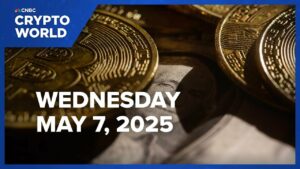Mevpool, the best bandaid that we have for mev

Bergmann extractable value. This expression is essentially one of the largest basic risk areas that are available for blockchain -based systems. The original conception of a blockchain included incentives for miners (or other consensus participants who decide the transaction order) in order to achieve revenue, based on the initial block subscription, which each become circulation the fees paid by the users to confirm their transactions.
These two things are no longer the only sources of revenue that encourage the actions of miners. More complicated contracts and protocols now exist to facilitate the creation and exchange between different assets that are hosted on a blockchain. These contracts enable open access to everyone. If you have a required asset and can meet the specified exchange conditions, each user can unilaterally interact with the contract or the protocol in order to exchange assets.
In view of the fact that the miners ultimately decide which transactions are included in blocks, miners receive the preferred access to “jump of the line” in interaction with such contracts and protocols. This represents a serious problem depending on the degree of complexity associated with the successful extraction of value from various contracts or protocols.
This creates enormous centralization pressure on the mining, the more complicated these contracts and protocols become. Miners have them Capability In order to collect all of this value, however, you actually have to analyze the current state of these contracts. The more complex the contract is, the more complex and more expensive analysis and the more centralization pressure it generates for miners.
This is terrible for censor resistance.
Separation of drive builders
Ethereum is the flagship of MEV, which went wrong. Due to the high complexity of the contracts used in Ethereum, the amount of MEV that was created in this chain was very large. Of course, they came up with the subject of tried to respond to the topic.
The separation of drive builders tried to mitigate the centralization risks of MEV by creating the separation between the two roles that were involved in the shift of the blockchain. Builders (block template manufacturers) process the role of actually putting transactions together in blocks, and applications (miners/stakers) choose between the available block templates to select the most profitable. The idea behind the proposal is that we can influence the centralization of template producers, but we can protect the miners/stakers from it. As long as there is a competitive market for template production, things should still be safe.
In practice, this is not what happened. The reality is that there are only a few competitive builders, and if the most profitable template producers decide to censor something, it is effectively censored by every miner/staker who decides to use these profitable block templates. In view of the fact that it is economically irrational not to choose the most profitable template, this does not really solve the risk of censorship.
Mevpool
Matt Corallo and 7d5x9’s MEVPOOL proposal is an attempt to change the PBS proposal for Bitcoin in such a way that the risk of censorship is actually reduced.
The main difference between PBS and Mevpool is that the outsourcing of the template construction is not totally, in Mevpool mountain people still construct the final block template themselves. They simply store the process of selecting the sub -quantity of transactions that optimize MEV extraction, including those in block templates that you can construct yourself. This aims to maximize their MEV reduction and at the same time maintain freedom, to include the desired transactions, in contrast to the binary choice, to accept censorship for maximum profit or to pursue profit to prevent censorship from PBS.
The proposal requires the establishment of Marketplace relay for HOST order books, in which MEV extractors can publish their proposed transactions and the fees they can pay for the inclusion of mining workers in a block. You would allow the extractor to define conditions under which he will pay for the conclusion of the transaction, i.e. only if you are the first transaction that interacts with a specific contract in the block. Market places would also support sealed or non -sealed orders, ie sealed inquiries are orders in which the proposed transaction is only actually announced to the Bergmann when they dismantle the block.
How is that supposed to work? All miners need the hash of a transaction to start the Merkle tree to start mining. You only need the complete transaction when you find a valid block and radiate it. However, you need to know that the transaction is valid. This is the role that the marketplace relays have to take on.
There are two ways to do this. First, it is easiest to be a purely trustworthy third party. MEV extractors would submit their transactions to relay operators, and miners would combine with these relays. They then requested the list of sealed and unpaid commandments from the Marketplace operator, including the Hashes that are required for the inclusion of sealed bids and to have a custom software construction of the block template. As soon as you have successfully found a valid block header, they broadcast the block minus the missing data to the relay.
The relay would then contain the complete sealed transactions, transmit the block itself and send the Bergmann the complete sealed transactions so that they could also transfer the block. During this entire process, the fee of the MEV extractor would be held from the Marketplace relay in the trust distributor and released the miner after found a valid block.
This requires that the relay to take up a lot of trust from the miners and the MEV extractors they pay, both from mining workers and the MEV extractors.
The second option is the use of a trustworthy execution environment (tea) in order to cope with the construction of block templates on the part of the miners and to edit the encrypted sealed bids. Miners would run the custom template software and a Bitcoin node in the T -shirt. After the miners received the sealed and unsealed bids and built their block, the T -shirt signed a certificate of the block and supplies the market for marketplaces a session key.
The marketplace would encrypt the sealed transactions and a transaction that pays the Bergmann their fee for the session key. After the miner had found a valid log hash destination that has reached the level of difficulty, the T -shirt decodes the sealed transactions and allows them to transmit the full block and collect their fee of MEV extractors. In this scenario, everyone involved must trust the T -shirt in order to remain safe.
The end result
In my opinion, the end result of this is very likely that it resembles PBS on Ethereum. There is only a handful of large builders who build MEV -optimized templates for miners, and they all have transactions that were transmitted from the tape directly from the mempool. Mevpool Marktsplace Relaus, both variations, are made publicly accessible. If large marketplaces were able to attract transaction applications that are not sent elsewhere and have retained these fees, this can generally influence users.
Even if it enables the mining workers to select their own transactions outside of the optimized MEV -optimized sub -group, it still leaves space for large marketplaces that receive private transaction applications to use this position. Such marketplaces could force miners to censor other transactions by holding their order book data from them if there was no competitor with access to the same information.
Ultimately, I do not see this as a solution for the topic of MEV, more as a bandaid or reduction of the worst possible effects. The centralization risk and the prints do not completely remove them, but improves them in certain areas.
This is a guest contribution by Shinobi. The expressions expressed are entirely their own and do not necessarily reflect the BTC INC or Bitcoin magazine.





